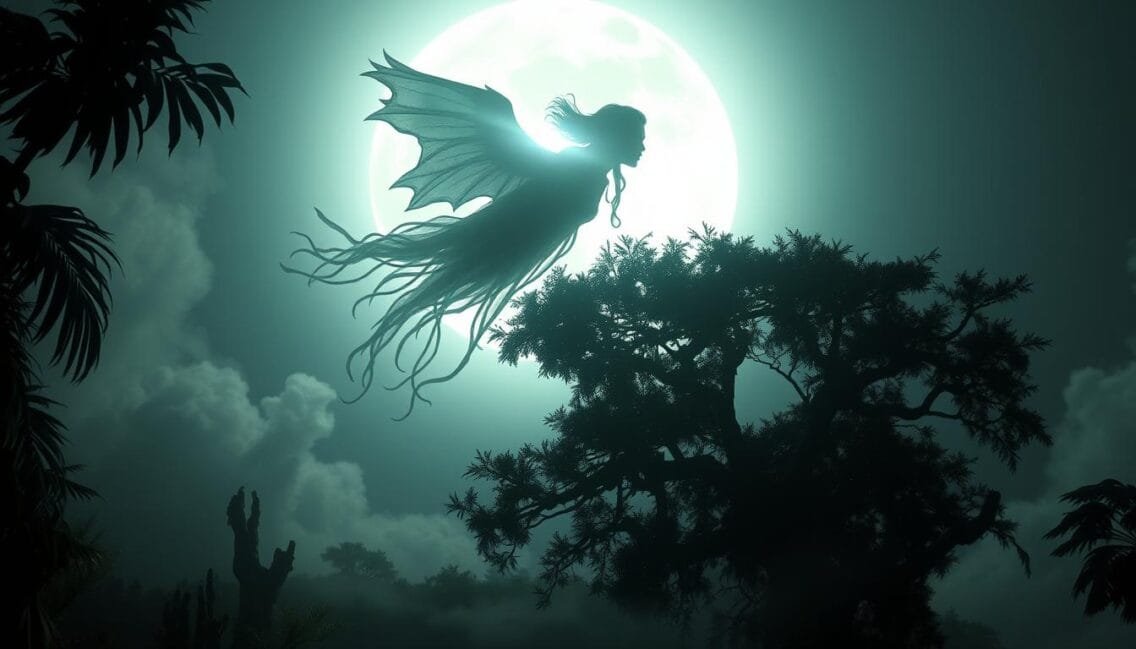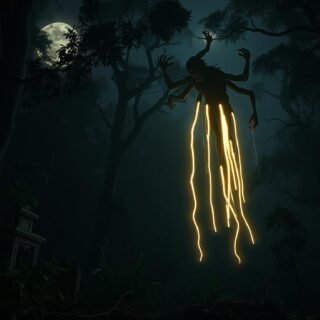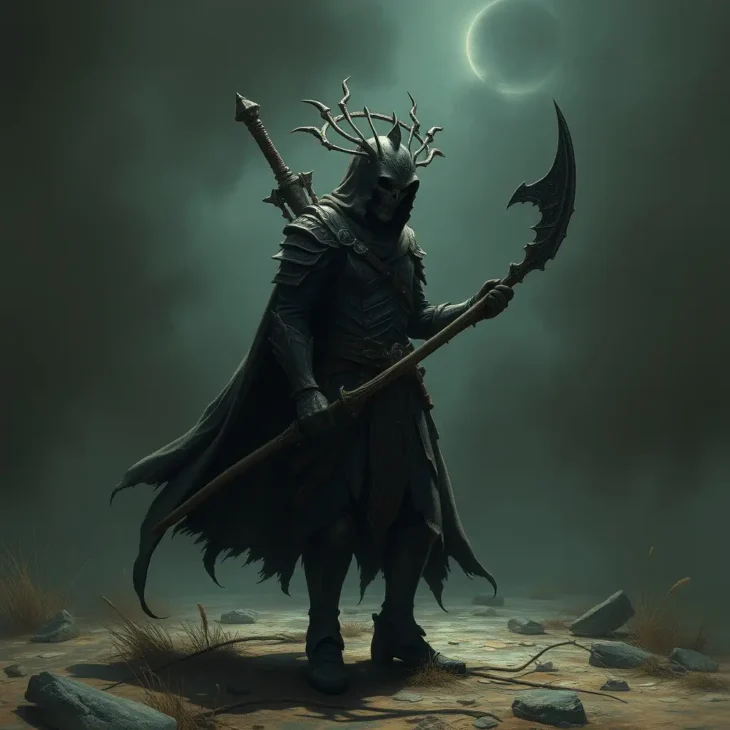The Penanggalan (Malaysia): A Ghostly Legend Lives On

The penanggalan is a captivating supernatural entity that has enthralled audiences across Malaysia for generations. This nocturnal vampiric creature is known for its distinctive appearance – a floating disembodied woman’s head with organs and entrails trailing from its neck. During the day, the penanggalan appears as a normal human, but when night falls, it transforms, seeking out the blood of its preferred victims: pregnant women and young children.
The penanggalan is part of a broader constellation of similar mythological entities found throughout Southeast Asia, including the Krasue in Thailand, the Manananggal in the Philippines, and the Ahp in Cambodia. These creatures, while sharing certain core traits, each possess their own unique characteristics and regional variations.
Key Takeaways
- The penanggalan is a nocturnal vampiric entity from Malay ghost myths that takes the form of a floating disembodied woman’s head with organs and entrails trailing from its neck.
- It belongs to a group of similar mythological entities found across Southeast Asia, including the Ahp in Cambodia, Kasu in Laos, and Manananggal in the Philippines.
- The penanggalan is known for hunting for blood, particularly from pregnant women and young children.
- It is a living human during the day but transforms at night, seeking out its preferred victims.
- The penanggalan legend is particularly pervasive throughout Malaysia, with variations such as Hantu Penanggal and Balan Balan.
Origins of the Malaysian Vampire Ghost
The penanggalan, a terrifying female vampiric entity from Malaysian folklore, has captivated the imagination of many. Its origins are deeply rooted in ancient black magic practices and regional variations across Southeast Asia. One legend states that a woman can become a penanggalan by meditating in vinegar during a ritual bath, a transformation that involves the violent detachment of her head from the body.
Ancient Folklore and Black Magic Connections
Another tale tells of a priestess who was startled while bathing, causing her head to violently separate from her body. This chilling event is believed to be the source of the penanggalan’s haunting origins. The creature’s predatory nature, with a preference for targeting pregnant women, newborn babies, and young children, has cemented its place as one of Malaysia’s most feared supernatural beings.
Regional Variations Across Southeast Asia
Across Southeast Asia, the penanggalan shares similarities with other ghostly entities, such as the Krasue in Thailand, Leyak in Indonesia, and Ma lai in Vietnam. These creatures all share the common feature of a disembodied woman’s head with trailing organs, a testament to the deep-rooted supernatural beliefs that span the region. The penanggalan’s influence has even extended beyond the realm of folklore, making appearances in popular media such as Dungeons & Dragons, Hellboy comics, and various RPG games.
The Penanggalan (Malaysia): Anatomy of a Night Hunter
The penanggalan, a legendary blood-drinking spirit in Malaysia, is a captivating and terrifying entity that haunts the nighttime shadows. This otherworldly creature appears as a normal woman during the day, but at night, its head detaches from the body, revealing a truly horrific sight. The disembodied head, glowing with crimson eyes and long, tangled hair, flies through the air with its internal organs and dangling entrails trailing below.
The penanggalan is said to possess a distinctive vinegar-like odor, a byproduct of the preservation techniques it employs to maintain its severed form. Its deadly tongue, invisible to the naked eye, is used to feed on the blood of its unsuspecting victims, who are often pregnant women, newborns, or those in a weakened state. From afar, the penanggalan can be mistaken for a rooftop ghost horror, a ball of flame resembling the eerie will-o’-the-wisp phenomenon.
The penanggalan’s transformation from a human to a blood-drinking spirit is the stuff of nightmares, evoking a sense of dread and fascination among those who encounter the legends surrounding this rooftop ghost horror. Its unique anatomy and predatory behaviors have captivated the imagination of storytellers and folklore enthusiasts alike, cementing its place as one of Malaysia’s most feared and revered supernatural entities.
From Human to Horror: The Transformation Process
The transformation into a penanggalan, the renowned vampire ghost of Malaysian folklore, is a harrowing process steeped in ancient rituals and dark pacts. According to legends, the journey from human to this malevolent entity often begins with a 40-day meat fast, a test of willpower that, if broken, seals the individual’s fate.
The 40-Day Meat Fast
The aspiring penanggalan must abstain from consuming any meat for 40 consecutive days, a challenging feat that serves as a gateway to the supernatural transformation. Failure to uphold this arduous fast is believed to trigger the curse, setting the individual on a path of no return.
The Vinegar Ritual
With the fast completed, the next step in the transformation involves a gruesome ritual. The individual must soak their internal organs, including the head, in a potent vinegar solution. This strange practice is said to shrink the organs, allowing the penanggalan to detach its head from the body and take flight as a disembodied, horrific entity.
Signs of a Hidden Penanggalan
The signs of a concealed penanggalan are subtle yet telling. Individuals suspected of harboring this vampire ghost may exhibit behaviors such as avoiding direct eye contact, persistently licking their lips when around pregnant women, and exuding a distinct vinegar-like odor. These telltale signs serve as warnings to the unsuspecting public of the hidden danger that lurks among them.
Hunting Patterns and Preferred Victims
The blood-drinking spirit known as the Penanggalan is feared throughout Malaysia for its relentless nocturnal activities. This detached head sightings preys primarily on pregnant women and newborn infants, seeing them as easy targets for its insatiable hunger.
The Penanggalan emerges under the cover of darkness, driven by an insatiable craving for blood. Using its long, invisible tongue, the creature slips through windows or floorboards to feed on its victims. Those who fall prey to the Penanggalan’s attacks often contract a fatal wasting disease, and even brief contact with its entrails can lead to incurable sores.
The Penanggalan is known to particularly enjoy feeding on the placenta and flesh of its victims, with lore stating that if it manages to consume a pregnant woman or newborn, it can go weeks without needing to hunt again. This has led the blood-drinking spirit to seek employment as midwives, granting it unfettered access to its preferred prey.
To protect themselves, communities have developed various traditional methods, such as placing thorny branches, broken glass, and protective amulets around homes during childbirth. These measures are believed to ward off the detached head sightings and prevent the Penanggalan from entering and claiming its victims.
The Midwife’s Double Life: Daylight Deception
In the shadowy world of the Penanggalan vampire ghost, these shapeshifting entities often disguise themselves as midwives, gaining easy access to their most vulnerable prey – pregnant women and newborn infants. During the day, the Penanggalan appears as a normal woman, making it challenging for locals to identify these nocturnal predators hiding in plain sight.
Professional Disguise
The Penanggalan’s ability to seamlessly blend into the community is a chilling aspect of their nature. Donning the garb of a respected midwife, they can move freely among pregnant women, conducting examinations and assisting in childbirths. This deceptive cover allows the Penanggalan to satisfy their insatiable hunger for the blood and life force of their victims.
Telltale Signs of Recognition
Despite their skilled disguise, the Penanggalan may exhibit certain behaviors that can reveal their true nature to the discerning eye. They often avoid direct eye contact, instead, licking their lips hungrily when in the presence of pregnant women. Additionally, these vampire ghosts may emit a strong vinegar odor that can serve as a warning sign to those familiar with the Penanggalan’s supernatural traits. Vigilance and awareness are crucial in identifying these Malaysia supernatural tales within the community.
Traditional Protection Methods Against the Flying Head
In the realm of Malaysia’s supernatural tales, the penanggalan, a ghastly flying head, stands as one of the most feared spirits. To safeguard against this rooftop ghost horror, the Malay community has long employed traditional protection methods passed down through generations.
Scattering thorny mengkuang leaves around windows and on rooftops is a common practice to trap the penanggalan’s entrails and prevent it from entering homes. Planting pineapple plants under stilt houses serves a similar purpose, deterring the vampire-like creature. Pregnant women may keep scissors or betel nut cutters under their pillows as a deterrent, while glass shards on walls provide dual protection against both penanggalans and intruders.
To destroy a penanggalan, one can fill its empty body with broken glass or prevent it from reattaching to its body before sunrise, effectively eliminating the threat. These traditional methods, rooted in Malay folklore and supernatural beliefs, offer a glimpse into the ingenuity and resilience of the Malaysian people in the face of their most feared spirit – the penanggalan.
Modern Urban Legends and Contemporary Sightings
While tales of the penanggalan, Malaysia’s infamous flying head ghost, may be more prevalent in rural areas and among older generations, modern urban legends persist. Occasional reports of contemporary sightings continue to emerge, particularly in remote regions where the legend remains deeply rooted in local folklore.
Recent Encounters
In recent years, a few reported sightings of the penanggalan have captured public attention. One incident in 2018 claimed that a woman in a small village had witnessed the detached head of a penanggalan gliding through the night sky, its ghostly entrails trailing behind it. Though met with skepticism by many, these types of accounts suggest that the belief in this supernatural entity has not entirely faded from Malaysian consciousness.
Digital Age Documentation
The digital age has brought new ways of documenting and sharing alleged encounters with the penanggalan. Social media platforms and online forums have become spaces where individuals can discuss their experiences with detached head sightings and other Malaysia supernatural tales. However, the proliferation of these stories has also led to increased skepticism, as many consider them to be remnants of traditional folklore rather than current supernatural occurrences.
Cultural Impact and Media Representations
The penanggalan, the captivating vampire ghost of Malaysian folklore, has transcended the realms of ancient tales and woven its way into popular culture. This eerie entity has left an indelible mark, appearing in various media forms that keep the legend alive and captivate modern audiences.
In 1981, the penanggalan made a notable appearance in the Dungeons & Dragons rulebook Fiend Folio, solidifying its status as a monstrous fixture in the world of fantasy gaming. That same year, the Indonesian horror film “Mystics in Bali” incorporated elements of the penanggalan legend, introducing this Malaysia supernatural tales to a wider cinematic audience.
The Penanggalan vampire ghost has also found its way into the pages of comic books, including the Hellboy series and the Image Comics title Cry Havoc. These creative adaptations not only pay homage to the rich Malaysian folklore but also reimagine the penanggalan for contemporary readers, ensuring that this Malaysia supernatural tales continues to captivate and intrigue.
Through its diverse media representations, the penanggalan has become a cultural icon, transcending its origins and embedding itself in the collective consciousness of audiences worldwide. These adaptations serve as a testament to the enduring power of this captivating creature, keeping the Penanggalan vampire ghost legend alive and thriving in the modern era.
Conclusion: The Enduring Legacy of Malaysia’s Most Feared Spirit
The Penanggalan, Malaysia’s iconic vampire ghost, remains a captivating figure in the nation’s rich folklore and supernatural tales. Despite waning belief in urban areas, this unique variation on vampire lore continues to captivate imaginations and inspire storytelling across the region. The Penanggalan’s presence in various Southeast Asian cultures demonstrates the interconnectedness of regional mythologies, showcasing the diverse tapestry of supernatural beings that have captured the collective consciousness.
As a symbol of cultural anxieties surrounding childbirth and the unknown, the Penanggalan stands out in the global pantheon of legendary creatures. Its distinct anatomy and hunting patterns, coupled with the intricate rituals and protection methods associated with the entity, have made it a staple in both traditional folklore and modern horror narratives. The Penanggalan’s enduring legacy ensures its place as one of Malaysia’s most feared and revered supernatural spirits.
From ancient tales of black magic and vinegar rituals to contemporary urban legends and digital age documentation, the Penanggalan continues to captivate audiences. This unique Malaysian vampire ghost serves as a testament to the power of regional mythologies to transcend time and space, leaving an indelible mark on the cultural fabric of the nation and beyond.
FAQ
What is the penanggalan?
What are the origins of the penanggalan?
Are there similar mythological entities found in other Southeast Asian countries?
How does the penanggalan transform at night?
What are the signs of a hidden penanggalan?
What are the penanggalan’s preferred targets?
How can a penanggalan be destroyed?
Are there any modern sightings or urban legends related to the penanggalan?
How has the penanggalan been represented in popular culture?
Source Links
- Penanggalan
- The Malaysian Penanggalan Haunts Pregnant Women and Newborns
- Penanggalan : The Vampire Lady – Mythlok
- Urban Legends – Penanggalan – Wattpad
- Image of Malaysia / Thailand: A penanggal or Southeast Asian vampire common
- Manananggal
- Vampire folklore by region
- Vampire
- Delving into the Origins of the Putrid Penanggalan
- Ghosts in Malay culture
- Microphone Therapy
- Monster Lore — Penanggalan
- Children – In The Dark Air
- Malicious Myths – In The Dark Air
- guest blog – HorrorAddicts.net
- Hantu Penanggalan
- Penanggalan
- GHOSTS, FOLK BELIEFS AND SUPERSTITIONS IN MALAYSIA
- INTRODUCTION
- Orang Minyak : The Oily Man – Mythlok
- A Dive into Cultures | Unveiling the Creepiest Mythical Creatures from Around the World | TW Languages
- Exploring Asian Cryptids Folklore: Myths, Legends, and Mysterious Creatures
- RPG Writeups — The Everlasting: Book of the Unliving





